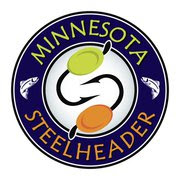De-mystifying Fin Clips
The use of fin clipping is a management tool widely used throughout the Great Lakes, and clips are used extensively in Minnesota's rainbow trout management program.
Each unique combination of clips help fisheries technicians as well as anglers to determine whether a fish is stocked or wild, the strain of rainbow trout stocked, the stocking location, potentially the age, and whether or not an angler can legally harvest the fish.
In Minnesota's portion of Lake Superior and its tributaries below the posted upstream boundary, only rainbow trout over 16 inches with a healed adipose clip may be harvested. The adipose fin is that big fleshy fin located on the back of the fish between the dorsal fin and tail. It is worth noting that while clipped fins do sometimes partially regrow, the adipose fin does not. If you are in doubt, CPR.
Other programs such as Wisconsin's continue to code fin clips using a letter designation from the actual fin name. Minnesota has simplified this approach for those of us who are anatomically-challenged with pectoral fins now designated as "F" for front, and ventral fins designated as "R" for rear. Additionally, each side is noted and coded as "R" for right and "L" for left. The end result being that a kamloops bearing an adipose and right pectoral clip would be coded as "ARF" in the clip guide: A = Adipose, R = Right, F = Front (pectoral fin).
A couple of final notes: Anal and caudal (tail) fin clips are rarely used, but are known from the technical literature although not in Minnesota that we are aware of. Maxillary clips however are in fact used in Minnesota to distinguish hatchery-reared steelhead from Kamloops. We have included two views here simply to illustrate the various fins more clearly. The first photo is a steelhead (yarn-fly in the beak), the second being a brook trout.
Each unique combination of clips help fisheries technicians as well as anglers to determine whether a fish is stocked or wild, the strain of rainbow trout stocked, the stocking location, potentially the age, and whether or not an angler can legally harvest the fish.
In Minnesota's portion of Lake Superior and its tributaries below the posted upstream boundary, only rainbow trout over 16 inches with a healed adipose clip may be harvested. The adipose fin is that big fleshy fin located on the back of the fish between the dorsal fin and tail. It is worth noting that while clipped fins do sometimes partially regrow, the adipose fin does not. If you are in doubt, CPR.
Other programs such as Wisconsin's continue to code fin clips using a letter designation from the actual fin name. Minnesota has simplified this approach for those of us who are anatomically-challenged with pectoral fins now designated as "F" for front, and ventral fins designated as "R" for rear. Additionally, each side is noted and coded as "R" for right and "L" for left. The end result being that a kamloops bearing an adipose and right pectoral clip would be coded as "ARF" in the clip guide: A = Adipose, R = Right, F = Front (pectoral fin).
A couple of final notes: Anal and caudal (tail) fin clips are rarely used, but are known from the technical literature although not in Minnesota that we are aware of. Maxillary clips however are in fact used in Minnesota to distinguish hatchery-reared steelhead from Kamloops. We have included two views here simply to illustrate the various fins more clearly. The first photo is a steelhead (yarn-fly in the beak), the second being a brook trout.






Comments